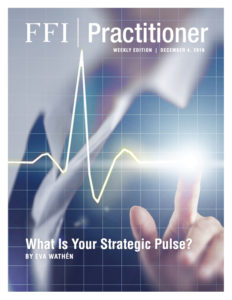
View this edition in our enhanced digital edition format with supporting visual insight and information.
How do we keep ourselves and our clients thriving during times of complexity and disruption? According to this week’s contributor, Eva Wathén, it comes down to resilience. Thanks to Eva for sharing this article, in which she presents the importance of taking your “strategic pulse.”
Resilience, VUCA, disruption, agile leadership, speed, self-leadership, entrepreneurial mindset –buzzwords we seem to be hearing almost daily in different contexts.
We are surrounded by change, complexity, complicated events, conflicts, and high-speed communications. It’s a lot of C’s to tackle. How do we keep ourselves and our clients productive while surviving and thriving in times of disruption and discontinuity? Or, how do you make sure everyone is sufficiently resilient to thrive these changes by turning them into opportunities?
What do we mean by resilience? One definition of resilience is by the British Standards Institution: “The ability of an organization to anticipate, prepare for, respond and adapt to incremental change and sudden disruptions in order to survive and prosper” (BS65000, Guidance on Organizational resilience).
Resilience is keeping your fingers on the pulse
According to the 2018 PWC Family Business Survey, only 15% of respondents claimed to have a succession plan in place to ensure a smoother succession to the next generation. This 15% seems to know the pulse of the business, ownership, and family, and have tools and remedies ready for any sudden hick-ups that may occur. They are preparing themselves to be resilient in the future.
However, what is the pulse of the remaining 85%? This dilemma has emerged in several of our company’s engagements with SME family businesses where the focus is on getting the business and ownership to the next level. The journey has not proceeded without roadblocks for either of them.
Putting a succession plan in place requires awareness of the family enterprise’s current strategic state. The difficulty arises when the company needs to make a shift from one strategic position to another. When working with these companies, our company uses the Cranfield School of Management resilience framework (below) when describing the strategic resilience of our family business clients:
Strategic tensions
According to this framework, there are four strategic tensions that leaders need to balance with their operational needs. The vertical axis is focused on a continuum from stopping negative actions from happening (defensive actions) to achieving positive results (progressive actions). The horizontal axis contains a spectrum from consistency (following rules and processes) and extablishing goals on one end, to a more flexible approach that looks for new ideas and innovations on the other end.
The paradox is that strategies need to be approached with a “both-and” perspective in the middle of the spectrums rather than the “either-or” perspective.
Two of our recent family business clients were stuck in the same strategic position, i.e. Mindful Action, whereby culture introduced a roadblock to the imposed strategy (see my earlier FFI Practitioner article in the Sidebar on the importance of company culture). The firms were very mindful of their personnel, which can be a common characteristic of family businesses in general. The employees were well taken care of, but this focus on personnel also resulted in inertia when it came to executing the necessary actions in pursuit of progress and adaptability to the new market conditions. Changes were difficult to propose as people continuously referenced the “good old times.”
Like other non-family companies, family businesses need to make sure they have a strong and steady strategic pulse as there are a growing number of C’s to tackle. A weak pulse usually indicates the need for some kind of shock to the system. Quite often, this shock takes the form of rapidly declining business results or misalignment within the family enterprise system.
In one of our cases, the “diagnosing doctor” was the new outside CEO. He quickly diagnosed the weak pulse and took the necessary corrective actions. The shift from being a mindful actor to a performance optimizer started with a few parallel changes — some to the surprise of the employees who were holding onto the old organizational culture. The pulse is healthier now, but will be further strengthened by an array of new insightful and innovative services and technologies. The company is moving towards Adaptive Innovation and has the necessary diagnostic tools to stand adverse situations. The key enabler of the change was the vision of the majority owner who took the pole position and supported the new CEO in taking the required actions to right the ship. Nonetheless, the business shifts have also indicated the need to revisit and update the owners’ strategy in order to ensure an aligned family business system as a whole.
Personal resilience
Tackling the C’s also requires mindfulness of personal resilience — matching competences and embracing a new culture. Resilient people may lose some resilience if the context is not right. As certified practitioners of the Resilience Alliance, my colleagues and I have the benefit of personal resilience surveys. The outcomes of the survey are designed to reflect the contextual setting of the respondent. This suggests the dynamic nature of organizational and personal resilience. Therefore, strategic changes require mindfulness at personal level as well as at the organizational level. If somebody is seemingly losing energy and efficiency, it is time for that person to take his or her own pulse and reflect whether there is need for:
- compliance to current change
- exploiting the personal competence in a different manner or in a different role
- introducing new skills or getting new experience in the current setting or in a new, different setting
Looking for alignment
In the case of our second client, the “doctor” was a leader from the next generation. He was hearing a weakening pulse through reports from an outside CEO. The company experienced an increasing need to put processes and practices in place and design an overall governance structure to support them. The growing competition introduced the need to look for new market opportunities, and the opposing culture between two generations implied a need to get mindful on cultural shifts. The needs of the external environment suggested new kind of competencies, speedier decision-making and smoother processes. The needed actions are now executed in a systematic manner and include changes both in terms of the whole family business system and the culture embracing it.
One cannot blame the 85% of family businesses that do not have a plan ready – at least not yet. It is not an easy task to balance the past and the future, or consistency and flexibility. Resilient organizations utilize their networks eagerly and systematically to get the needed help for future take-offs.
I believe that our task as family business advisors is to ensure that the strategic resilience journey is aligned with the prevailing culture and the competencies and traits of the participants involved, getting a synchronized and steady pulse and an aligned family business system.
About the Contributor
 Eva Wathén holds an Advanced FFI Certificate in Family Business Advising. She has worked in a variety of roles in family business settings, is an entrepreneur, and a certified coach. She has her master’s degree from the University of Surrey, holds an eMBA, and has begun to pursue MSc studies in the field of Applied Psychology.
Eva Wathén holds an Advanced FFI Certificate in Family Business Advising. She has worked in a variety of roles in family business settings, is an entrepreneur, and a certified coach. She has her master’s degree from the University of Surrey, holds an eMBA, and has begun to pursue MSc studies in the field of Applied Psychology.
About Bravemotion Oy
Bravemotion Oy is a Finnish company working in the field of leadership development to pave the way for a high-performance culture and the individual growth of leaders. Founded by Eva Wathén and Tuija Janakka, Bravemotion works in multidisciplinary teams and has a wide network of experts and specialists for the benefit of the customer.

View this edition in our enhanced digital edition format with supporting visual insight and information.





